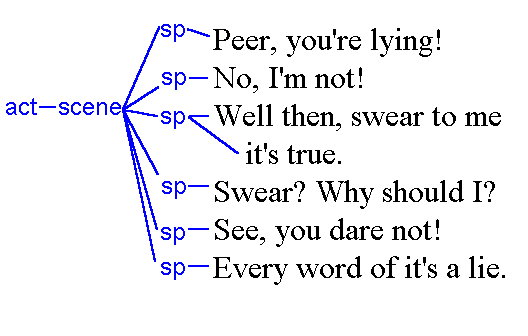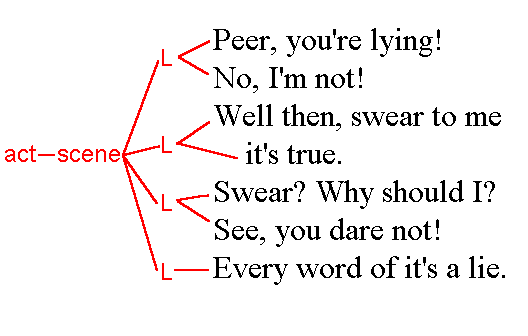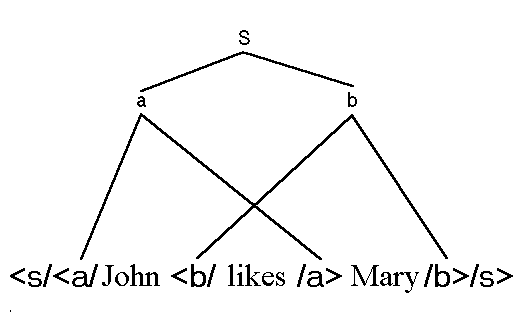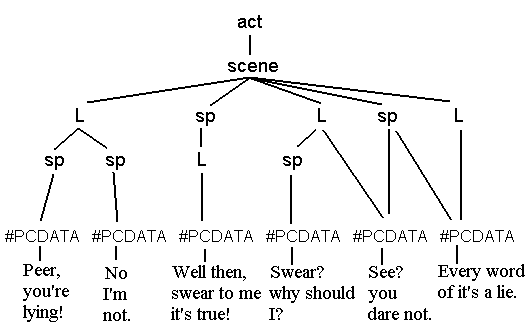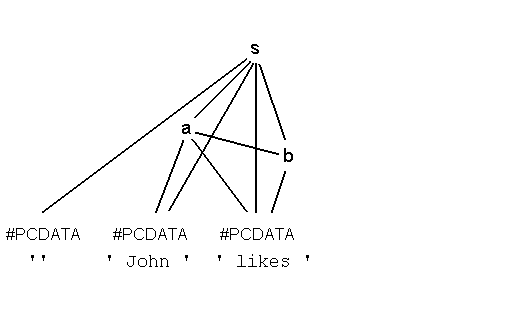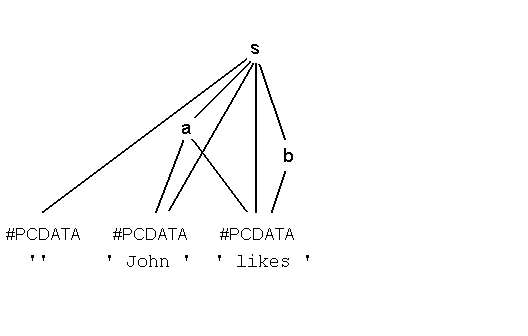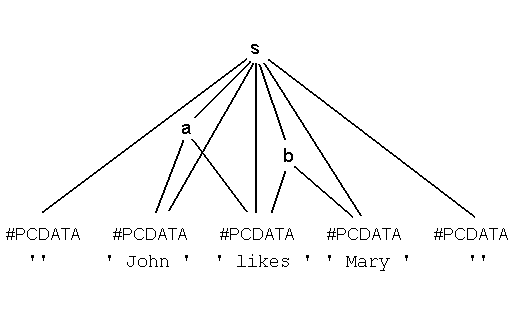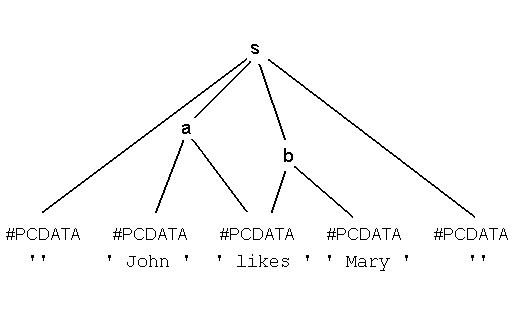GODDAG: A Data Structure for Overlapping Hierarchies
C. M. Sperberg-McQueen 1 and Claus Huitfeldt 2
1 World Wide Web Consortium / MIT Laboratory for Computer Science
cmsmcq@acm.org
2 University of Bergen / Humanistic Information Technology Centre
Claus.Huitfeldt@hit.uib.no
[[This paper was published in DDEP-PODDP 2000, ed. P. King and E.V. Munson, Lecture Notes in Computer Science 2023 (Berlin: Springer, 2004), pp. 139-160. The version given here differs in some minor ways from the published volume. It was generated from a pre-final version of the text, so it may differ in some details from the final publication. Footnote and bibliographic references are styled slightly differently. Post-publication additions and corrections are enclosed in double square brackets.]]
- 1. The Problem of Overlap
- 1.1. Document Structure and Interpretation
- 1.2. Overlap
- 2. Dealing with Overlap
- 2.1. Non-SGML Notations
- 2.2. CONCUR
- 2.3. Marked Sections and Entity References
- 2.4. Milestones
- 2.5. Fragmentation
- 2.6. Standoff Markup
- 2.7. MECS
- 3. GODDAG
- 3.1. Informal Presentation
- 3.2. Restricted GODDAGs
- 3.3. Generalized GODDAGs
- 3.4. Applications
- 3.5. Open Questions
1. The Problem of Overlap
1.1. Document Structure and Interpretation
<lg> <l>Summer grass --</l> <l>all that's left</l> <l>of warriors' dreams.</l> </lg>
Fig. 1. A simple document hierarchy
<p><s><del>Der Anblick</del> <add>Das Bild </add><del>der</del> <add>einer</add> menschlichen Gestalt sowie die menschliche Gestalt selbst sind uns wohlvertraute Gegenstände.</s> <s>Von einem Wiedererkennen aber ist hier keine Rede.</s></p>The start-tags mark the beginning of a passage characterized by some feature (e.g. being a paragraph, or having been deleted), the matching end-tags mark the end of the passage. In a markup language with conventional interpretation, the label on each node in the tree identifies some feature possessed by the subtree it dominates. Sometimes the feature is possessed by the subtree as a unit, as with the p element here; sometimes it is inherited by each part of the subtree, as with the del and add elements here.
.
Fig. 2. Wittgenstein ms 115, p. 7
1.2. Overlap
In English:AASE: Peer, du lyver!PEER GYNT : Nej, jeg gjør ej!AASE: Naa, saa band paa, det er sant!PEER GYNT: Hvorfor bande?AASE: Tvi, du tør ej!
Alt ihob er Tøv og Tant!
AASE: Peer, you're lying!PEER GYNT : No, I'm not!AASE: Well then, swear to me it's true.PEER GYNT: Swear? why should I?AASE: See, you dare not!
Every word of it's a lie.
<sp who='Aase'> Peer, you're lying! </sp>
<sp who='Peer'> No, I'm not! </sp>
<sp who='Aase'> Well then, swear to me
it's true! </sp>
<sp who='Peer'> Swear? why should I? </sp>
<sp who='Aase'> See, you dare not!
Every word of it's a lie!
</sp>
<l> Peer, you're lying! No, I'm not! </l> <l> Well then, swear to me it's true! </l> <l> Swear? why should I? See, you dare not! </l> <l> Every word of it's a lie! </l>
the metrical structure in Fig. 4.
Fig. 3. Tree of dramatic view.
Fig. 4. Tree of metrical view
Fig. 5. Tangled hierarchy
2. Dealing with Overlap
2.1. Non-SGML Notations
<l>
<sp who='Aase'> Peer, you're lying! </sp>
<sp who='Peer'> No, I'm not! </sp>
</l>
<l>
<sp who='Aase'> Well then, swear to me
it's true! </sp>
</l>
<l>
<sp who='Peer'> Swear? why should I? </sp>
<sp who='Aase'> See, you dare not!
</l>
<l>
Every word of it's a lie!
</l>
</sp>
The failure of the elements to nest properly makes it impossible to
create an SGML document type definition (DTD) for the document, and
thus impossible to use SGML or XML tools to process it.2.2. CONCUR
<div1 type="act">
<(D,V)div2 type="scene">
<(V)l>
<(D)sp who='Aase'> Peer, you're lying! </(D)sp>
<(D)sp who='Peer'> No, I'm not! </(D)sp>
</(V)l>
<(V)l>
<(D)sp who='Aase'>
Well then, swear to me
it's true! </(D)sp>
</(V)l>
<(V)l>
<(D)sp who='Peer'> Swear? why should I? </(D)sp>
<(D)sp who='Aase'> See, you dare not!
</(V)l>
<(V)l> Every word of it's a lie!</(D)sp>
</(V)l>
...
</(D,V)div2>
</div1>
Note that each tag carries, in parentheses, the names of the root
elements of the concurrent document types to which it applies;
when the tag belongs to all concurrent views, the list may be
exhaustive, as shown in the <div2> tags, or omitted,
as shown in the <div1> tags.2.3. Marked Sections and Entity References
2.4. Milestones
<sp who='Aase'><lb n="1"/> Peer, you're lying! </sp> <sp who='Peer'> No, I'm not! </sp> <sp who='Aase'><lb n="2"/> Well then, swear to me it's true! </sp> <sp who='Peer'><lb n="3"/> Swear? why should I? </sp> <sp who='Aase'> See, you dare not! <lb n="4"/> Every word of it's a lie! </sp>
2.5. Fragmentation
<sp who="Aase"> <l part="i">Peer, you're lying!</l> </sp> <sp who="Peer"> <stage>without stopping</stage> <l part="f">No, I'm not!</l> </sp> <sp who="Aase"> <l part="n">Well then, swear to me it's true!</l> </sp> <sp who="Peer"> <l part="i">Swear? Why should I?</l> </sp> <sp who="Aase"> <l part="f">See, you dare not!</l> <l part="n">Every word of it's a lie.</l> </sp>
2.6. Standoff Markup
<sp who="Aase"> <l id="L1a">Peer, you're lying!</l> </sp> <sp who="Peer"> <stage>without stopping</stage> <l id="L1b">No, I'm not!</l> </sp> <sp who="Aase"> <l id="L2">Well then, swear to me it's true!</l> </sp> <sp who="Peer"> <l id="L3a">Swear? Why should I?</l> </sp> <sp who="Aase"> <l id="L3b">See, you dare not!</l> <l id="L4" >Every word of it's a lie.</l> </sp>The <join> elements themselves each signal the existence of a virtual element of type <l>, created by concatenating the elements pointed at by the targets attribute:
<joinGrp result="l" targOrder="y" targType="L"> <join scope="branches" targets="L1a L1b"/> <join scope="branches" targets="L3a L3b"/> </joinGrp>
2.7. MECS
- start-tags (in the form <e/) mark the start of a feature
- end-tags (/e>) mark the end of a feature
- no-element codes (<e>) mark a feature with location but no content (these correspond to SGML empty elements)
<sp/<speaker/Aase/speaker>
<l/ Peer, you're lying! /sp>
<sp/<speaker>Peer/speaker>
No, I'm not! /l> /sp>
<sp/<speaker/Aase/speaker>
<l/ Well then, swear to me it's true! /l>
/sp>
<sp/<speaker/Peer/speaker>
<l/ Swear? Why should I? /sp>
<sp/<speaker/Aase/speaker>
See, you dare not! /l>
<l/ Every word of it's a lie! /l> /sp>
3. GODDAG
3.1. Informal Presentation
<s/<a/ John <b/ likes /a> Mary /b>/s>
Fig. 6. A trivial overlap example: John likes Mary
Overlap can be represented by graphs that are very like trees, but in which nodes may have multiple parents.
/
Fig. 7. Another view of John likes Mary.
Fig. 8. Peer Gynt 1.1
3.2. Restricted GODDAGs
- A GODDAG is a directed acyclic graph in which each node is either a leaf node or a nonterminal node.
- Each leaf node is labeled with a string of zero or more characters.
- Each nonterminal node is labeled with a generic identifier.
- Directed arcs connect nodes; if an arc a → b exists, we say that node a directly dominates node b; we also call b a child of a. If a directed path of length zero or more from a to b exists, we say that node a dominates node b. If the path is of length one or more, then we call b a descendant of a.
- Leaf nodes are those which are not the starting point of any arc.
- Nonterminals are all others.
- For any three nodes a, b, and c, if arcs a → b and b → c exist, then there is not an arc a → c. This amounts to saying that no node dominates another node both directly and indirectly.
- The leaf nodes form a sequence. For any two leaf nodes
a and b,
Each leaf node except the first has a predecessor, and each leaf node except the last has a successor. The sequence of leaf nodes we call the frontier.(a) a < b (in which case we say that a precedes b in the document), or(b) a > b (and b precedes a), or(c) a = b (in which case they are the same node)
- Each node dominates some contiguous subsequence of leaf nodes. I.e. if node n dominates leaf nodes a and b, and a < b, then for any leaf node c such that a < c < b, node n dominates c.
- No two nodes dominate the same subsequence of the frontier. I.e. for any two nodes a and b, there will be at least one leaf node c such that a dominates c but b does not dominate c, or vice versa.
- If s is a start-tag, then
(a) Make an element node n labeled with the appropriate generic identifier(b) For each element node e in the list of open elements, add an arc e → n.(c) Add n to the list of open elements.
- If s is a character data segment,
then (a) Create a PCDATA node p labeled with the appropriate string.(b) For each element node e in the list of open elements, add an arc e → p.
- If s is an empty-element tag, then (a) Make an element node n labeled with the appropriate generic identifier(b) For each element node e in the list of open elements, add an arc e → n.(c) Make a PCDATA node p labeled with the empty string.(d) Add an arc n → p.
- If s is an end-tag, then At this point, there may be illegal arcs from n to other nodes (n may be dominating some other nodes both directly and indirectly). We remove them thus:(a) Find the element node n created for the corresponding start-tag, and remove n from the list of open elements.(b) If n is not the most recently created element node in the list of open elements, then for each node m which was created more recently than n remove the arc n → m. These elements are not wholly contained in n and thus should not be dominated by n.(c) Record the set of nodes dominated by n for later use. (This is the set of nodes x for which an arc n → x exists.)For each descendant d of n, examine the set of nodes dominated by d. For each node m dominated by d, remove the arc n → m if it exists.
- Every node created is labeled either with a string or with a generic identifier.
- Every node labeled with a generic identifier is given at least one outgoing arc; no node labeled with a string is given any outgoing arc.
- At completion of the end-tag processing for any node n, any arcs n → d have been removed if d is dominated by any descendant of n. Therefore, for each node n there is no node which is both directly and indirectly dominated by n.
- If the leaf nodes are numbered in the order they are read, then we have a total ordering on the leaf nodes, and each leaf node d occurring between the start-tag and the end-tag for any nonterminal node n is dominated by n: an arc n → d is created when d is read, and the arc is removed only if n indirectly dominates d. If the arc is not removed, n dominates d directly in the resulting graph; if the arc is removed, n dominates d indirectly. Since this is true for every d between the start- and end-tags of n, we can conclude that n dominates a contiguous subsequence of the leaf nodes.
- Since every start-tag s is immediately followed by a character data segment d (possibly containing the empty string), and d is dominated by the node for s but not by any node for elements with start-tags occurring later in the document, it follows that no two nodes dominate subsequences of the frontier which begin with the same character data segment. It follows in turn that no two nodes dominate the same subsequence of the frontier.
<s/<a/ John <b/ likes /a> Mary /b>/s>we will process, in turn, eleven segments:
- The start-tag <s/.
- A character-data segment containing the empty string.
- The start-tag <a/.
- A character-data segment containing the string " John ".
- The start-tag <b/.
- A character-data segment containing the string " likes ".
- The end-tag /a>.
- A character-data segment containing the string " Mary ".
- The end-tag /b>.
- A character-data segment containing the empty string.
- The end-tag /s>.
Fig. 9. GODDAG construction after the word “likes” is read
There are no doubly dominated nodes, so no further arcs are removed. After adding the character-data segment for " Mary ", processing the end-tag for the <b> element does not cause any arcs to be removed. After processing the empty string between the <b> and <s> end-tags, the graph is shown in Fig. 11.
Fig. 10. GODDAG construction after “/a>” is read
At this point, we remove the direct arcs from s to the leaf nodes other than the first and last. The result is shown in Fig. 12.
Fig. 11. GODDAG construction after “/s>” is read
Fig. 12. GODDAG construction at completion
3.3. Generalized GODDAGs
- For any nonterminal node n, the set of arcs
from n to some other node are ordered. For any two arcs
n → a and n → b,
(a) n → a < n → b (in which case we say that node a precedes b among the children of n, or(b) n → a > n → b (in which case we say that node b precedes a among the children of n, or(c) n → a = n → b (in which case they are the same arc)
- There is no single ordering on the leaf nodes, and requirement that the leaf nodes dominated by any node be contiguous. (In the absence of a single ordering, there is no way to express the notion that a set of leaf nodes is or is not contiguous.)
- There is no requirement that any two nodes dominate different sets of leaf nodes.
3.4. Applications
<a/ John <b/ likes /a> Mary /b>If any one of the regions is empty, then the overlap is spurious: the document can be rewritten without overlap, without changing the interpretation of any character of the document. Here are three examples of spurious overlap.
<a/<b/ John likes /a> Mary /b> <a/ John likes <b//a> Mary /b> <a/ John likes <b/ Mary /a>/b>
<b/<a/ John likes /a> Mary /b> <a/ John likes /a><b/ Mary /b> <a/ John likes <b/ Mary /b>/a>
3.5. Open Questions
- formal proof that the transformation of a MECS document into a GODDAG structure, followed by the serialization of the GODDAG structure into a MECS document, produces a new MECS document equivalent to the old
- demonstration of the use of GODDAG structures in processing documents with overlap (e.g. in indexing and search and retrieval applications)
- algorithms for translating SGML/XML documents which use any of the techniques described in the first part of this paper into GODDAG structures, and vice versa
References
1. Association for Computers and the Humanities (ACH), Association for Computational Linguistics (ACL), and Association for Literary and Linguistic Computing (ALLC). 1994. Guidelines for Electronic Text Encoding and Interchange (TEI P3), ed. C. M. Sperberg-McQueen and Lou Burnard. Chicago, Oxford: TEI, 1994.
2. Barnard, David, Ron Hayter, Maria Karababa, George Logan, and John McFadden. 1988. “SGML-based markup for literary texts: Two problems and some solutions.” Computers and the Humanities 22: 265-276.
3. Barnard, David T., Lou Burnard, Jean-Pierre Gaspart, Lynne A. Price, C. M. Sperberg-McQueen, and Giovanni Battista Varile. 1995. “Hierarchical encoding of text: Technical problems and SGML solutions.” Computers and the Humanities 29: 211-231.
4. Bray, Tim, Jean Paoli, and C. M. Sperberg-McQueen, ed. Extensible Markup Language (XML) 1.0 [Cambridge, Mass., Sophia-Antipolis, Tokyo]: World Wide Web Consortium, 1998. [[3d ed. 2004 edited by the above with Eve Maler and François Yergeau. Available at http://www.w3.org/TR/REC-xml/]]
5. Goldfarb, Charles F. The SGML Handbook. Oxford: Clarendon Press, 1990.
6. International Organization for Standardization (ISO). 1986. ISO 8879: Information processing — Text and office systems — Standard Generalized Markup Language (SGML). [Geneva]: ISO, 1986.
7. McKelvie, D., C. Brew, and H. S. Thompson. 1998. “Using SGML as a basis for data-intensive natural language processing.” Computers and the Humanities 31: 367-388.
8. Murata, M. 1995. “File format for documents containing both logical structures and layout structures.” Electronic publishing 8: 295-317.
9. Sperberg-McQueen, C. M., and Claus Huitfeldt. 1999. “Concurrent document hierarchies in MECS and SGML.” Literary & Linguistic Computing 14.1: 29-42.
10. Sperberg-McQueen, C. M., Claus Huitfeldt, and Allen Renear. 2000. “Meaning and Interpretation of Markup.” Markup Languages Theory & Practice [forthcoming]. [[Published in 2.3 (2000): 215-234. Available at http://www.w3.org/People/cmsmcq/2000/mim.html]] Paper originally presented at ALLC/ACH 2000, Glasgow, and at Extreme Markup Languages 2000, Montréal.


